Posts Tagged: anthracnose
What's All This Now?
This is interesting. In the midst of all this heat and dry I found a big run of anthracnose infected fruit, and the grower shared with me that something like 5 to 10% of his crop has the disease currently. For those who think the grower or I might be confused about this, have a look at the pictures below taken Monday early morning.
So what I did was contact Steve Koike and ask him, that seemed like a smart thing to do. He answered and said that at some point there must have been enough moisture to activate the spores. It does boil down to the "disease triangle" and each of the three requirements must be in place. We have the host (strawberries), the pathogen (Colletotrichum) and now all we need to do is have the right condition (a lot of moisture). Checking around with other growers in that area, it does seem that very close to the coast the dews over the past week were really heavy, in one case so much that one manager had to delay a spray. So the third requirement has been fulfilled after all.
Since I was able to surveil a number of fields in both Santa Cruz and Monterey counties these past few days on a soil sampling run, I found that sure enough even a little further inland the disease to is nowhere to be found. It truly does depend on the right conditions.
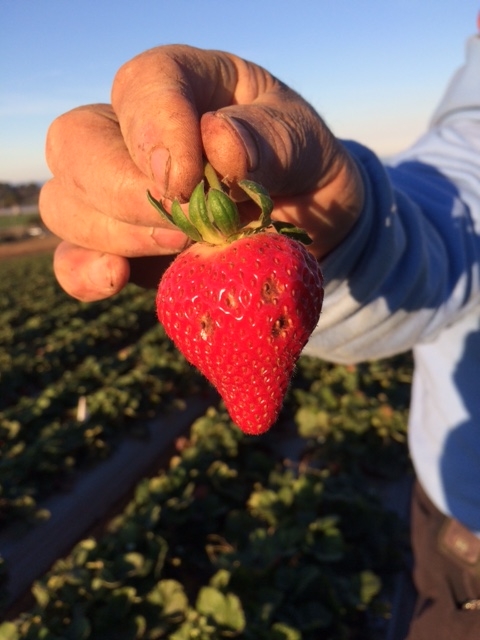
Not the most encouraging thing to see at first light on the farm - a berry spotted with anthracnose.
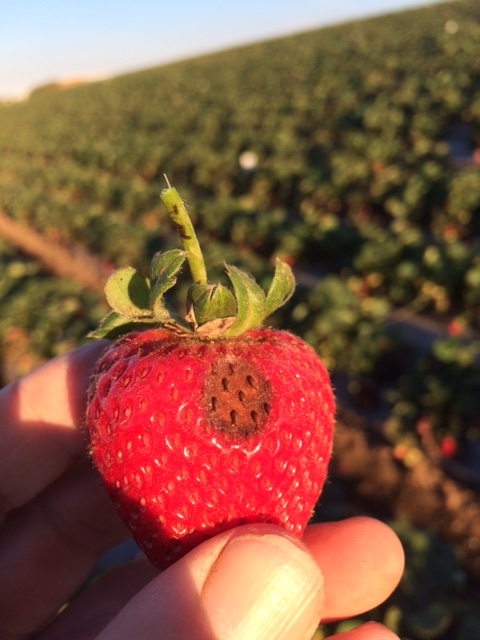
Better example of anthracnose on strawberry in the autumn of 2017.
Management of Anthracnose with Pre-Plant Fungicide Dip Treatments in 2016
Very nice presentation of management with pre-plant fungicidal dips of anthracnose given by Gerald Holmes of CalPoly of work he did together with Jim Adaskaveg, Doug Gubler, Stacy Haack, Helga Foerster and Kelly Ivors did earlier this year.
Look at the presentation, it's very well done. The upshot (copied directly from the concluding slide) is as follows:
1. Actinovate had NO efficacy on anthracnose in the conditions of this study.
2. Azoxystrobin (Abound) is highly effective in controlling Colletotrichum if the strain is sensitive, but not effective if the strain is resistant.
3. Switch is highly effective as a dip in controlling Colletotrichum in all the cases of this study. No phytotoxicity was detected in the conditions of this study (ie 4 minute dip with agitation, followed by 5 to 10 minutes drip drain).
4. Two new compounds, EXP-13 and Syngenta-2 (not registered yet) were found with high efficacy.
Link here:
http://content-calpoly-edu.s3.amazonaws.com/strawberry/1/documents/2016AnthracnoseUCR.pdf
Anthracnose Meeting in Strawberry Planned for September 28
On September 28, UC Cooperative Extension will be leading an anthracnose meeting in anticipation of the upcoming strawberry planting. Location will be the auditorium of the UCCE Building at 1430 Freedom Blvd, Suite E.
Yes, we will cater breakfast, and it will be good! Courtesy of Syngenta, we'll be having bacon, eggs, ham, fresh fruit, juice, coffee and the works.
Format of the meeting will be much the same as we did a few months ago with our lygus meeting. Information will be presented by real experts on anthracnose and its management, but participants are encouraged to comment, ask questions and explore the topic in its entirely.
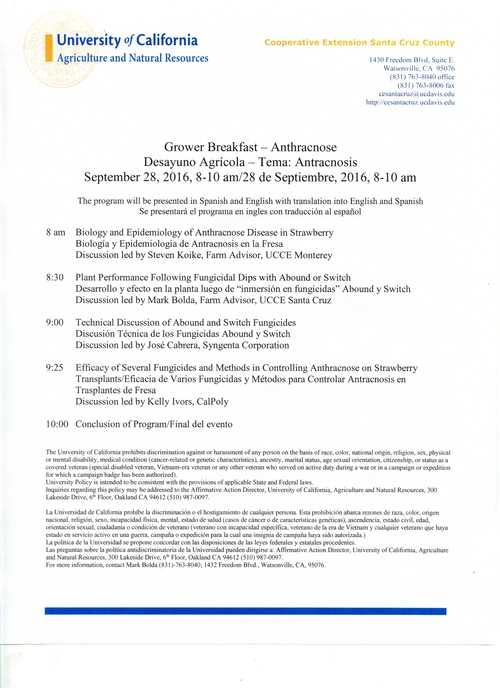
September 28 UCCE Meeting on Anthracnose Disease in Strawberry.
A Review on Anthracnose Disease Caused by Colletotrichum acutatum in Strawberry
While anthracnose has been a very minor problem on Central Coast strawberry up to now, this disease is known to be most severe when there are winter and spring rains. In late 2015 and early 2016, anthracnose cases have been a concern for some growers in southern California. Therefore a brief review of anthracnose would be appropriate and is presented here.
Symptoms: The anthracnose pathogen is rather unique in that this fungus can infect virtually all parts of the strawberry plant, though some infections are more important than others. Most symptoms on above-ground parts of plants consist of dark, elongated lesions. If warm, wet field conditions are present, such lesions will contain orange masses of the pathogen's spores. For below-ground parts, symptoms consist of decayed, darkened roots, discoloration of the internal crown tissue, and wilting and collapsing plants; therefore, the root and crown phases of anthracnose will closely resemble symptoms caused by Phytophthora and other soilborne pathogens. Table 1 lists the major symptoms on strawberry.
Table 1. Anthracnose symptoms and signs on strawberry
|
Strawberry tissue |
Symptoms |
Orange spore masses?
|
|
root |
discolored, rotted roots, causing leaves to wilt |
no |
|
crown |
discolored internal crown, causing leaves to wilt |
no |
|
leaf petiole |
dark brown, elongated lesions |
yes |
|
leaf blade |
gray to brown spots |
yes |
|
runner |
dark brown, elongated lesions |
yes |
|
flower peduncle (stem) |
dark brown, elongated lesions |
yes |
|
flower |
discolored tissue, causing flower to shrivel |
sometimes |
|
fruit |
brown, oval to round, firm, dry sunken spots |
yes |
Pathogen: Anthracnose on strawberry in California is primarily caused by Colletotrichum acutatum, though strawberry is also host to additional Colletotrichum species. C. acutatum is found worldwide on strawberry and many other crop and weed hosts. Some of these other hosts include the following: almond, celery, delphinium, pepper, pine tree, tomato, walnut, zinnia, chickweed, fiddleneck, vetch. It is unclear to what extent C. acutatum from non-strawberry hosts can infect and cause significant damage to strawberry. For example, researchers have found that strawberry isolates of C. acutatum are more aggressive and damaging to strawberry than isolates from other hosts. Therefore, C. acutatum is likely composed of diverse strains or sub-types that have some degree of host specificity or preference.
Disease Cycle: Colletotrichum acutatum is not a true soil inhabitant and cannot survive in the soil indefinitely. Studies show that this pathogen, under California conditions, can remain viable in the soil for about 9 months without a strawberry host. Based on this limited survival capability and the pattern and sporadic distribution of disease when it does develop, disease occurrence in fumigated fields is primarily due to infested or diseased strawberry transplants. The disease is favored by moderate temperatures (60 to 85 degrees F) and wet, humid weather. The development and spread of spores is strongly dependent on sprinkler irrigation and rain. The spores form in a sticky matrix and will only spread through physical contact (such as from passing equipment that brushes against the lesions) or splashing water. Therefore, anthracnose disease on strawberry fruit is very rare unless rains occur during the fruit production season.
Pre-plant control measures: Pre-plant applied soil fumigants likely will reduce most of any remaining inoculum in the soil. However, information is limited on how well non-methyl bromide containing treatments reduce soilborne inoculum. Hot water treatment of transplants can reduce the level of anthracnose. Prior to planting, dipping transplants in fungicides (such as Abound and Switch) can also reduce anthracnose. Such treatments need to be done carefully; damage has occurred to transplants dipped in Switch but not immediately planted. However, plant injury was not observed in a Ventura County experiment in which plants were dipped for 2-3 minutes in Switch (5 oz/100 gal) and then planted within 30 minutes. If considering plant dips, consult with fungicide product representatives and UC extension personnel.
Post-plant control measures: Avoid the use of overhead sprinklers. During the production growing season, if rainy weather occurs and there are concerns with or detections of anthracnose, foliar sprays are warranted. Captan, Abound, and Switch are registered and are effective in reducing disease. Note that these are protectant materials only and need to be applied prior to infection. If foliar lesions are abundant, keep in mind that passing equipment can spread spores to previously uninfected plants and blocks. If feasible, remove diseased fruit and collapsing or dead plants since these plant parts are sources of secondary inoculum.
In most cases, accurate identification of anthracnose requires laboratory analysis and testing. Before using any fungicides, check with your local Agricultural Commissioner's Office and consult product labels for current status on registration, restrictions, and use. For additional information on anthracnose and other strawberry diseases, consult the UC IPM Pest Management Guidelines:
http://ucipm.ucdavis.edu/PMG/r734101011.html
(English and Spanish versions are available).
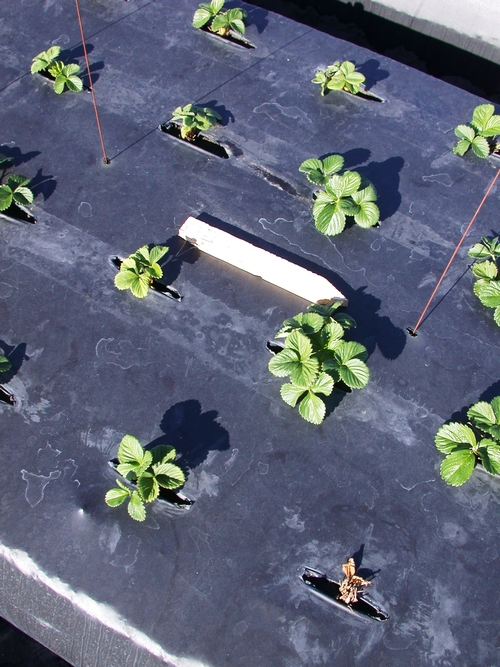
Poor growth of C. acutatum inoculated plants with some decline and mortality 6 wks after planting. Photo Oleg Daugovish, UCCE.
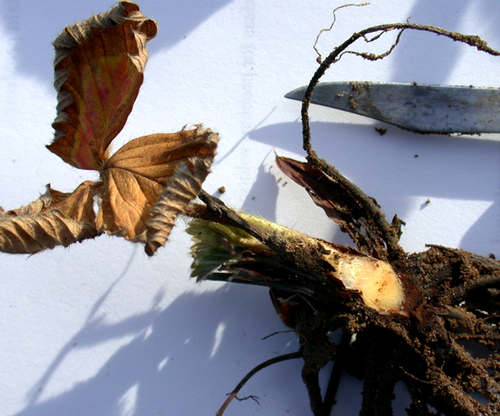
Early season die-back on C. acutatum infected strawberry. Photo Oleg Daugovish, UCCE.
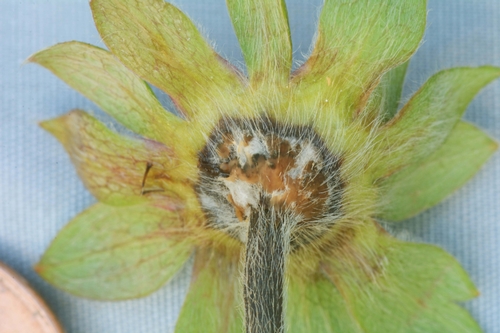
Strawberry blossom infected with C. acutatum. Photo, Steven Koike, UCCE.
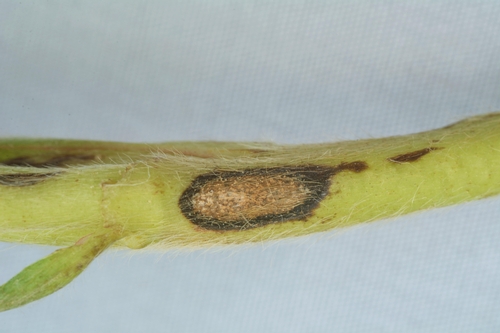
Anthracnose lesion on stem of strawberry. Photo Steven Koike, UCCE.
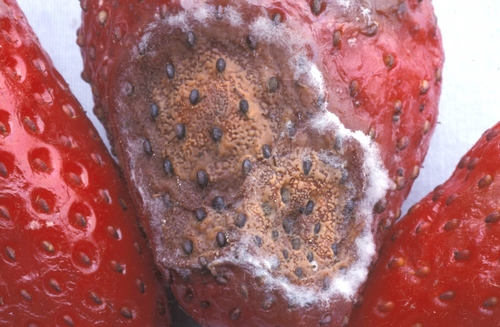
Advanced anthracnose lesion on strawberry fruit. Photo Steven Koike, UCCE.
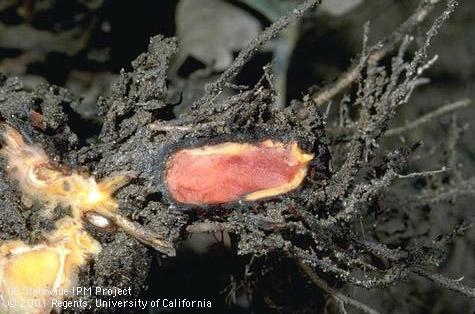
Discolored crown of strawberry caused by C. acutatum. Photo UC IPM.
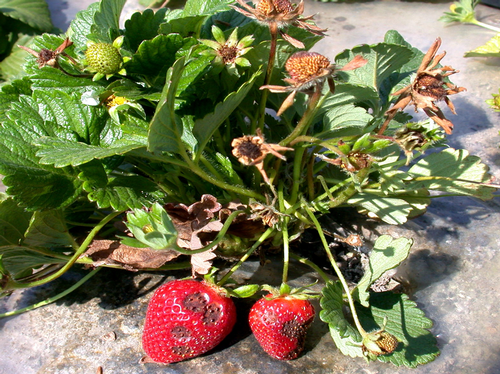
Late-season symptoms on C. acutatum infected strawberry. Photo Oleg Daugovish, UCCE.
Is Anthracnose a Concern on Strawberry in Fall 2015?
To address the current concern of anthracnose in strawberry for the upcoming 2015-2016 season, Ed Show, Steve Koike and I put together a video featuring a discussion of the issue. It's good to talk about it because it's not a cut and dry case.
For example, out of dozens of suspect samples for anthracnose recently submitted to Steve's UCCE Diagnostic Lab in Salinas, only one has turned up positive for the causal pathogen Colletotrichum acutatum. On the other hand, this winter is supposed to be warm and wet, which could favor the disease if it is around.
The discussion taped here with Steve and I is intended to shed more light on the current situation and help people make a good decision in a timely manner.
Great videography and editing by Ed Show. Really great work.
https://www.youtube.com/watch?v=u2N7Yrm06iY
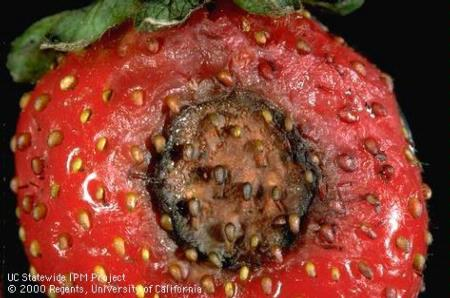
What do the experts really think about the situation of anthracnose on strawberry this fall?

